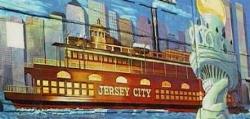 |  |  |
|
| ||
 |  |  |
 |  |  |
|
| ||
 |  |  |

 |
 |

Originally published in 1939
Some of this information may no longer be current and in that case is presented for historical interest only.
Edited by GET NJ, COPYRIGHT 2002
South Dennis-Rio Grande-Wildwood; State S49.
Running southeast, the road skirts tidal marshes and travels through a
sandy scrub-pine area. Signs of habitation are few except in the small farming and fishing villages. Numerous muskrat houses, rough piles of sticks'
and mud in marshy ground, are easily seen in autumn when the screening growth of summer vegetation dies.
State S49 branches south fro State 49 (see Tour 29) at SOUTH
DENNIS, 0 m. (115 alt., 310 pop.) (see Tour 29).
GOSHEN, 3.5 m. (10 alt.), is a center for surrounding farmers and
fishermen. Most of its homes are small and weather-beaten.
South of Goshen there are fewer houses. Swampy woodlands (L) and
salt marshes (R) draw closer. Farms are narrow strips beside the roads,
and most farmers gain some income from the bay. Tidal streams and
marshes penetrate the upland (L).
At 6.1 m. is the junction with a dirt road.
Right on this road is REED'S BEACH, 1 m. (5 alt.), a fishing center for amateurs, with a few summer cottages.
At 6.6 m. (R) is C.C.C. Camp MC-73. The letters stand for "mosquito
control" ; the 300 youths here have been ditching and draining the
marshes.
DIAS CREEK, 8.7 m. (15 alt., 126 pop.), is the site of an unusual
industry-the king crab business. Locally called horseshoe crabs because
of their shape, they are a survival of a distant geologic age. Near Dias
Creek they are caught in large pounds or traps, brought to the shore, and
boiled. The cooked meat is sold for chicken feed and the remnant is
ground up for fertilizer. Originally known as Dyer's Creek, the community's name was changed many years ago when phonetic spelling was used
in an application for a post office.
GREEN CREEK, 10.8 m. (15 alt.), serves summer guests. It is the
gateway to several small vacation resorts on the bay shore.
Southward the highway turns from the bay shore and enters farming
country.
At 13 m. is the junction with a dirt road.
Right on this road is NUMMYTOWN, 0.6 m. (15 alt.). It bears the name of
the last local chief of the Unalachtigo Indians, King Nummy, who sold the remaining 16 miles of land along the bay shore prior to 1700. The Indians then moved
to the less desirable Atlantic shore. Nummy spent the rest of his days on an island
at the mouth of Hereford Inlet, that is still called Nummy's Island.
Opposite the junction in a field on the Locke farm 0.2 miles east of the
road is (L) an unmarked INDIAN BURIAL GROUND. Bones are plowed up
almost every spring; according to legend, King Nummy was buried here.
A rude gravestone found years ago is in the museum at Cape May Coca
House (see Tour 18), along with Indian implements and ornaments, most
of them from Nummy's Island.
RIO GRANDE, 13.8 m. (20 alt., 375 pop.) (see Tour 18), is at a junction with US 9 (see Tour 18).
State S49 follows Rio Grande Ave. across the flat sand of Cape May
and crosses the Intracoastal Waterway.
WILDWOOD, 18.3 m. (5 alt., 5,330 pop.), is a summer resort and
port of call for the Atlantic fishing fleet. The shipments of cod, mackerel,
and other fish are among the largest on the coast. Built around two small
villages in 1912, the city shares a 5-mile ocean frontage with North Wildwood, West Wildwood, and Wildwood Crest, and embraces the business
South Dennis to Wildwood, 18.3 m.
Two-lane concrete roadbed.
|
Return To |
|

|